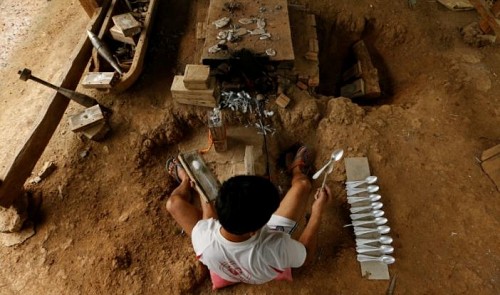Almost half a century later, scars from the U.S. Air Force's bombings are still visible in Laos' Xieng Khouang Province, the area in the impoverished country most heavily bombed during the American war in Vietnam.
From 1964 to 1973, U.S. warplanes dropped more than 270 million cluster munitions on Laos, one-third of which did not explode, according to the Lao National Regulatory Authority for unexploded ordnance (UXO).
The bombings were part of a CIA-run, secret operation aimed at destroying the North Vietnamese supply routes along the Ho Chi Minh trail and wiping out its allies. They left a trail of destruction in Laos, with U.S. planes also using the country as a dumping ground for bombs when their original target was unavailable and planes couldn't land with explosives.
U.S. bombs are still killing in Laos - over 20,000 people have been killed or injured since the bombing stopped.
Kek, 28, is one of many U.S. bomb legacy victims, after losing both his hands when accidentally detonating a bomb while searching for scrap metal. Many of the homes in his area are held up by U.S. bomb shells serving as pillars.
Fifty-eight percent of those killed or injured by unexploded bombs in Laos from 2013 to 2015 were under the age of 14, according to UK-based Mines Advisory Group (MAG), which has been helping to find and destroy UXO in Phaxay district since June.
International organizations like MAG have been working with local villagers, training them to uncover bombs and educating them on what to do when they encounter suspicious objects.
Yianyang Bounxieng, 28, is a villager working as a support officer for MAG, and says the arduous task of clearing the explosives will help local families live better lives.
Using beeping metal detectors, a team of local technicians survey a hillside for unexploded bombs. They find a BLU-26 cluster bomb, the size of a tennis ball, and mark it for demolition. As many as 106 other BLU-26 bombs have been found on the site over the past two months.
It is still unclear how long removing the threat of unexploded bombs will actually take, though a few estimates exist.
Neil Arnold, MAG's technical operations manager, says a technical survey providing a clearer picture of the scale of the problem is expected in five years time. He also estimates it will take another 20 years to get to the stage of having just "residual risk" in the country.
Without a promising timeframe to finally remove all unexploded bombs, some locals in Napia Village have decided to work with it - a home factory in the area turns the scraps of metal from bomb shells into spoons.
Addressing the legacy of war in Laos will be a focus of U.S. President Barack Obama's trip to Laos this week, during which he will participate in the Association of Southeast Asian Nations (ASEAN) summit and East Asia Summit.
Obama, the first U.S. president to visit Laos, is expected to announce more funding to help clear the leftover bombs and conduct Laos' first national survey on unexploded ordnance.
"If America feels guilty," says local village Vanvissa Vandee, "I want them to come and help completely dispose the remaining explosives from Laos."
Land-locked Laos remains largely agricultural with around 80 percent of the population reliant on agriculture. Some land is simply too dangerous to farm.
























































